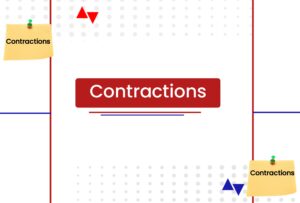Est. reading time: 4 minutes

A contraction is simply a word that is formed by combining two words or by shortening or omitting a word or phrase. They are also called short forms and are formed with the use of an apostrophe. The apostrophe, also known as contractive apostrophe, is placed where the missing letter should be. Contractions are used in our daily communication, both oral and written. They are used to save time when speaking.
Types of contractions
Contractions can be divided into four different forms. These include;
1. Subject pronoun + Verb contractions
This is the combination of subject pronouns and verbs to form contractions. Examples of these include I’m, you’re, he’s, she’s, they’re, I’ve, you’ve, we’ve, they’ve, I’ll, she’ll, it’ll, he’ll, it’d, she’d, I’d, they’d, we’d, etc. Some of these forms of contraction used in sentences can be found in the sentences below:
- You’re not going to the party with us.
- They’d locked the gate when we got to school.
- I’ll complete all the assignments by midnight.
- We’ve been going to see the homeless man down the street.
2. Verb + Not contractions
This is the combination of verbs and the word “not” to form contractions. This is also known as negative contractions. The word “not” is shortened to n’t and is placed behind the verb. Examples of these include isn’t, aren’t, wouldn’t, shouldn’t, wasn’t, weren’t, hadn’t, haven’t, hasn’t, won’t, don’t, doesn’t, didn’t, mightn’t, oughtn’t, shan’t, needn’t, can’t, etc. Some of these forms of contraction used in sentences can be found in the sentences below:
- Going out alone isn’t safe for the prince.
- You shouldn’t throw stones at the birds.
- I wasn’t going to get up, but my rumbling stomach forced me out of bed.
- The homeless man down the street told me that he didn’t have a family.
- You needn’t say things that you don’t mean.
- I shan’t leave until you speak to me.
- If it weren’t for Dave, the stray dog would have bitten me
3. Verbs + Words that ask questions
This combines verbs and words that ask questions like who, where, why, how, etc. Examples of these contractions include who’s, where’s, why’s, what’s, how’s, why’d, who’d, when’d, what’re, how’ll, etc. Some of these forms of contraction used in sentences can be found in the sentences below:
- Why’s the dog sleeping on the bed?
- Where’s my scarf?
- What’re you doing there?
- How’ll you get to school?
- Who’d go to see the Potters?
- Why’d you draw on the walls, Abby?
4. Informal contractions
Informal contractions are words or phrases in English that are shortened for informal conversations and sound like slang in many ways. Examples include ain’t (am not), y’all (you all), gonna (going to), wanna (want to), shoulda (should have), coulda (could have), kinda (kind of), gimme (give me) etc. Some of these forms of contraction used in sentences can be found in the sentences below:
- I ain’t going.
- Y’all make too much noise
- He’s not gonna stay.
- Gimme the books.
List Of Contractions And Their Meanings
| Contraction | Meaning | Contraction | Meaning | Contraction | Meaning |
| I’m | I am | That’ll | That’ll | You’d | You had, You would |
| She’s | She is, She has | They’ll | They will | I’d | I had, I would |
| He’s | He is, He has | We’ll | We will | Why’d | Why had, Why would |
| It’s | It is, It has | You’ll | You will | Who’d | Who would, Who had |
| What’s | What is, What has | How’ll | How will | When’d | When had, When would |
| How’s | How is, How has | Who’ll | Who will | How’d | How did, How would |
| There’s | There is, There has | Where’ll | Where will | I’ve | I have |
| Which’s | Which is, which has | They’re | They are | You’ve | You have |
| Where’s | Where is, Which has | Who’re | Who are | We’ve | We have |
| Isn’t | Is not | You’re | You are | Who’ve | Who have |
| Aren’t | Are not | Where’re | Where are | Could’ve | Could have |
| Wouldn’t | Would not | Don’t | Do not | Should’ve | Should have |
| Shouldn’t | Should not | Doesn’t | Does not | Might’ve | Might have |
| Wasn’t | Was not | Didn’t | Did not | What’ve | What have |
| Weren’t | Were not | Mightn’t | Might not | Must’ve | Must have |
| Hadn’t | Had not | Oughtn’t | Ought not | Where’ve | Where have |
| Haven’t | Have not | Shan’t | Shall not | Would’ve | Would have |
| Hasn’t | Has not | Needn’t | Need not | Let’s | Let us |
| Won’t | Will not | Can’t | Cannot | T’was | It was |
When To Use and When Not To Use Contractions
1. Contractions are not to be used in formal writing
Contractions are accepted in several forms of writing (such as articles, newspapers, fictional writing, etc) but never in formal writing. It is better to avoid using contractions in formal writing.
2. Contractions are not to be mixed with possessive words
Possessive words are words that show ownership. Contractions and possessive words may be mistaken for each other because they both involve the use of apostrophes. For example, in the sentence “Wale’s house was robbed,” the apostrophe that comes after Wale is used to show possession. While in the sentence, Wale wasn’t at the house when it was robbed, the apostrophe is used to show contraction. Contractions can also be mistaken for possessive pronouns that sound like contractions. Examples of possessive words that may be confused for contractions include:
- Its, instead of it’s.
- Your, instead of you’re.
- Their, instead of they’re
3. Contractions are used in question tags.
Question tags are short phrases or words added to a sentence to make it a question that typically inquires if the sentence is true or not. Contractions are added to words or used in sentences to make them question tags. Examples of question tags include;
- We are lost, aren’t we?
- You failed the test, didn’t you?
- He heard everything we said, didn’t he?
- She isn’t going to fail, is she?
- You don’t plan to confront her, do you?
What Is the Difference Between Contractions and Conjunctions?
Conjunctions are words that connect or link other words or phrases together. Contractions, as stated earlier, are words formed by combining two words or by shortening or omitting a word or phrase. In other words, contractions shorten words for easier communication, whereas conjunctions join words together within sentences.
Conclusion
Contractions are a part of our daily communication. Therefore, an understanding of them is vital. If understanding contraction has been a problem for you, then the article above will help you. Make sure to check our blog for other articles that would help improve your English language skills.

